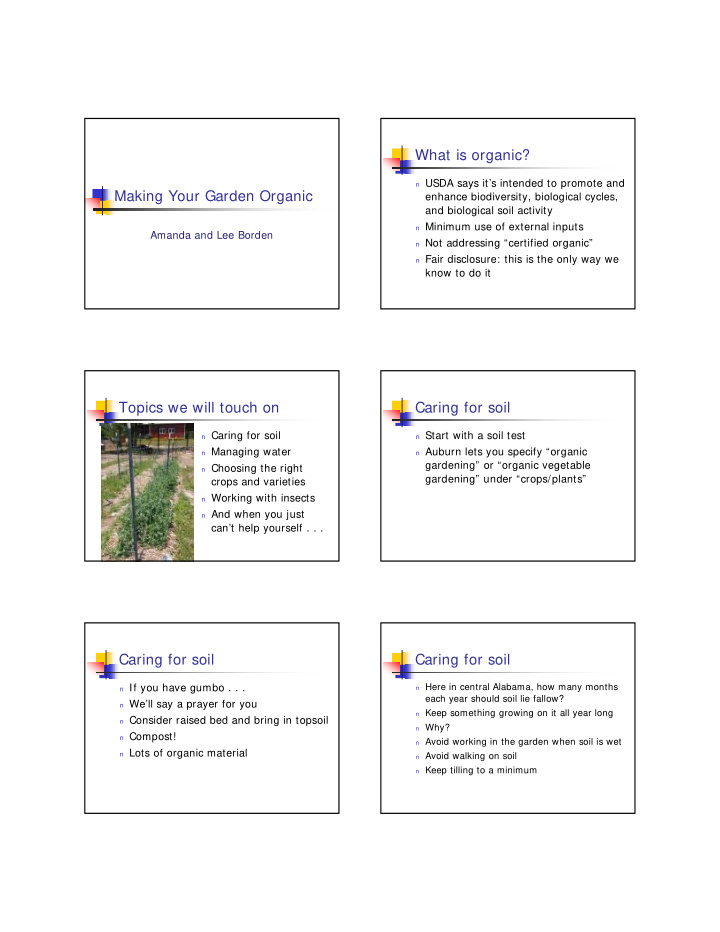



What is organic? n USDA says it’s intended to promote and Making Your Garden Organic enhance biodiversity, biological cycles, and biological soil activity n Minimum use of external inputs Amanda and Lee Borden n Not addressing “certified organic” n Fair disclosure: this is the only way we know to do it Topics we will touch on Caring for soil n Caring for soil n Start with a soil test n Managing water n Auburn lets you specify “organic gardening” or “organic vegetable n Choosing the right gardening” under “crops/plants” crops and varieties n Working with insects n And when you just can’t help yourself . . . Caring for soil Caring for soil n If you have gumbo . . . n Here in central Alabama, how many months each year should soil lie fallow? n We’ll say a prayer for you n Keep something growing on it all year long n Consider raised bed and bring in topsoil n Why? n Compost! n Avoid working in the garden when soil is wet n Lots of organic material n Avoid walking on soil n Keep tilling to a minimum
Managing water Resistant varieties n Work to keep soil moisture level n Amanda’s saga with squash consistent n Avoid: Pepo (yellow squash, spaghetti n Too much water just as bad as too little squash, and zucchini) n Water deeply and infrequently n Avoid: Maxima (buttercup squash) n Minimize erosion n Resistant: Moschata – Butternut n Avoid overhead sprinkling, especially in n Still a work in progress! late afternoon n Drip irrigation or soaker hose Working with insects Exclusion n What percentage of insect species are n Row cover harmful to our gardens? n The overwhelming majority of insect species are either harmless or beneficial Attracting Pollinators Good things bugs do n Pollination n Butterflies and bees n Food for lizards, birds, toads, and frogs n Bee balm, sunflower, black eyed Susan, goldenrod, butterfly bush, purple n Keep soil aerated and improve texture coneflower, and butterfly weed n Recycle nutrients
Attracting Predators and Attracting Predators and Parasitonoids Parasitonoids n In general, you can’t go wrong: n These are the good guys: n Plant flowers that produce pollen and n Lady beetles n Spined soldier bugs nectar n Braconid wasps n Ground beetles n Hover flies n Plant sheltering plantings (perennials) n Robe beetles n Lacewings n Tiger beetles n Tachinid flies n Assassin bugs n Soldier beetles Our aphid story Our tomato hornworm story n Green beans attacked by aphids n Hate ‘em n No action (other than cussing) n Companion planting – French marigolds and basil n Next year – help arrives! n And even . . . Trap Cropping Our lesson about insect pests n Plant a crop known to attract the pest n Be patient n Wait, then plant target crop n Scout regularly n Kill the pests on the trap crop n Squish and stomp (insecticide, vacuum, or hand pick) n Don’t overreact n Help will (often) come n And help doesn’t come, maybe try something else
When you just can’t help yourself – organic pesticides Resources ANR-0063 – Planting Guide for Home Gardening in n ANR-1428 is a great resource n Alabama n Use pesticides as a last resort ANR-0638 – Backyard Composting n ANR-1045 – Garden Bugs n n Follow label directions! ANR-1425 – Buying Organic – What Does It Mean? n ANR-1428 – Insecticides for Organic Commercial & n n Avoid contact with blooms Backyard Vegetable Production University of Georgia Extension, Insect Identification n Apply in late evening – bees not n Guide for Southern Landscapes foraging Ellis, Barbara and Bradley, Fern Marshall, eds., The n Organic Gardener’s Handbook of Natural Insect and Disease Control
Recommend
More recommend